Taxation Law: Practical Application and Legal Analysis - HI6028
VerifiedAdded on 2023/03/31
|6
|1838
|127
Homework Assignment
AI Summary
This assignment provides detailed solutions to taxation law questions, covering Capital Gains Tax (CGT) events, collectables, and personal exertion income as per Australian tax legislation. It analyzes scenarios involving the sale of assets, including paintings, sculptures, and jewellery, determining tax implications based on purchase dates and relevant sections of the ITAA. The assignment also addresses the taxability of payments received for services, copyright assignments, and the sale of manuscripts, referencing key legal cases to support its conclusions. Finally, it examines the tax implications of interest payments on loans between family members, distinguishing between ordinary income and capital receipts. The document is available on Desklib, a platform offering study tools and solved assignments for students.
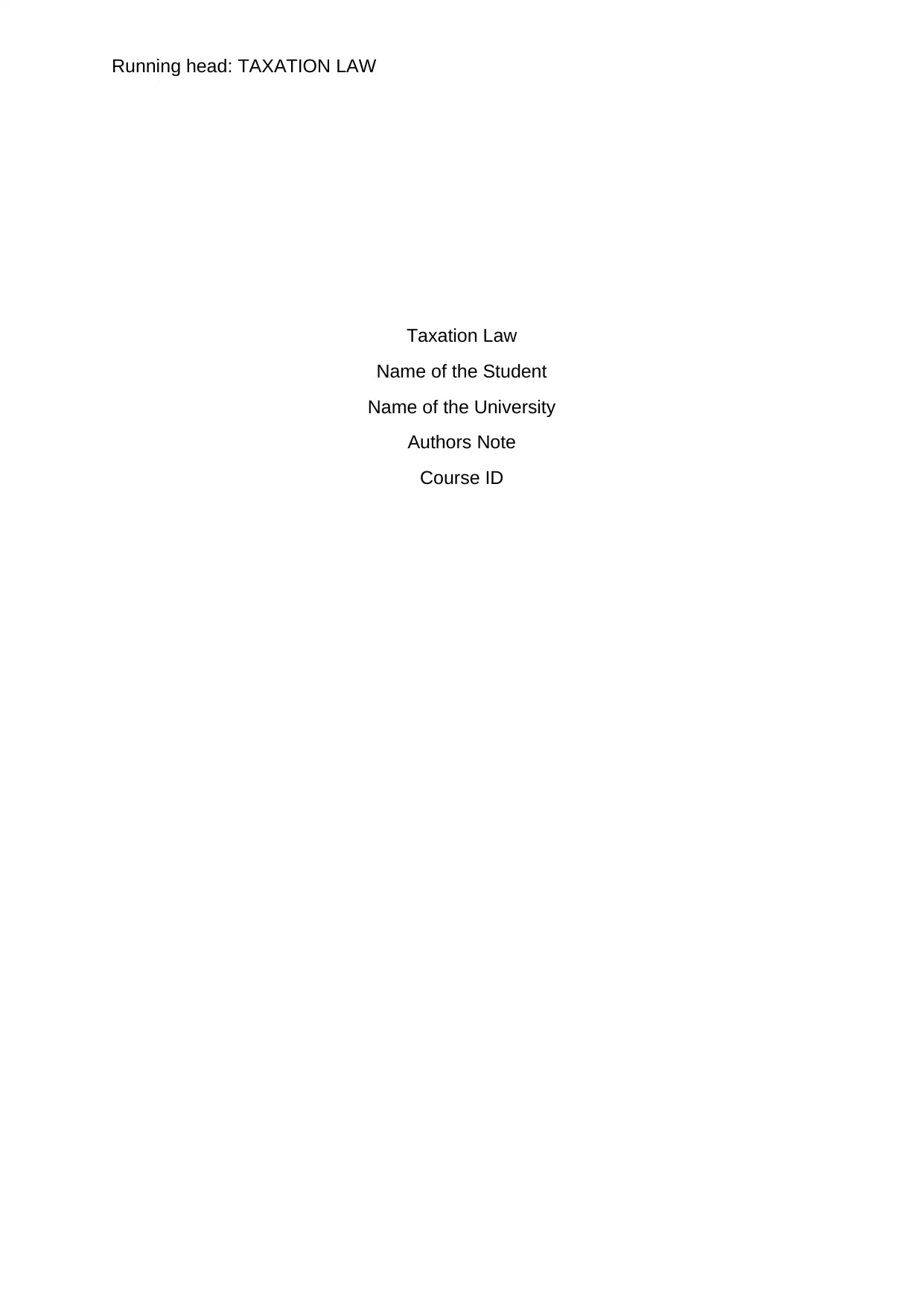
Running head: TAXATION LAW
Taxation Law
Name of the Student
Name of the University
Authors Note
Course ID
Taxation Law
Name of the Student
Name of the University
Authors Note
Course ID
Paraphrase This Document
Need a fresh take? Get an instant paraphrase of this document with our AI Paraphraser
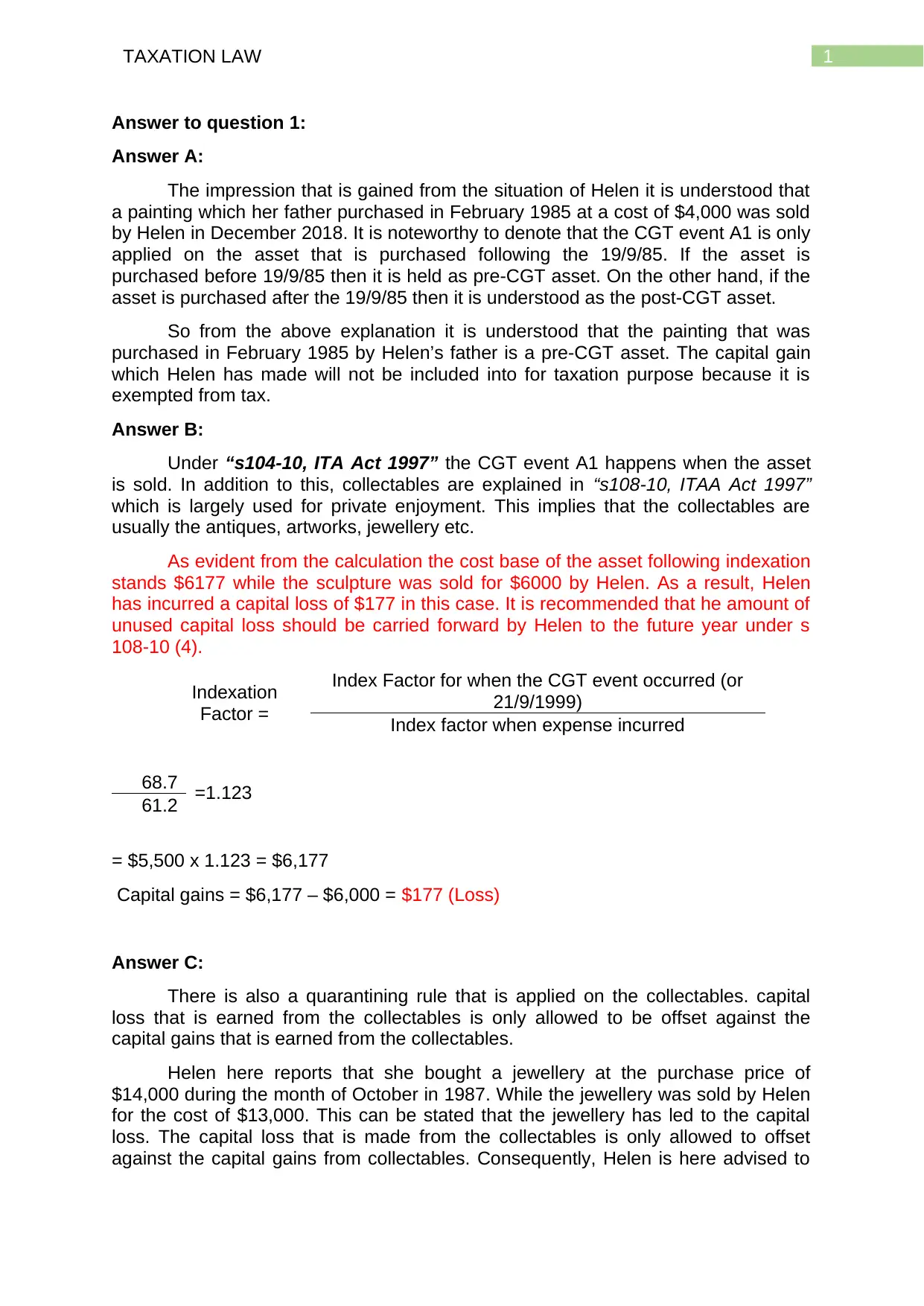
1TAXATION LAW
Answer to question 1:
Answer A:
The impression that is gained from the situation of Helen it is understood that
a painting which her father purchased in February 1985 at a cost of $4,000 was sold
by Helen in December 2018. It is noteworthy to denote that the CGT event A1 is only
applied on the asset that is purchased following the 19/9/85. If the asset is
purchased before 19/9/85 then it is held as pre-CGT asset. On the other hand, if the
asset is purchased after the 19/9/85 then it is understood as the post-CGT asset.
So from the above explanation it is understood that the painting that was
purchased in February 1985 by Helen’s father is a pre-CGT asset. The capital gain
which Helen has made will not be included into for taxation purpose because it is
exempted from tax.
Answer B:
Under “s104-10, ITA Act 1997” the CGT event A1 happens when the asset
is sold. In addition to this, collectables are explained in “s108-10, ITAA Act 1997”
which is largely used for private enjoyment. This implies that the collectables are
usually the antiques, artworks, jewellery etc.
As evident from the calculation the cost base of the asset following indexation
stands $6177 while the sculpture was sold for $6000 by Helen. As a result, Helen
has incurred a capital loss of $177 in this case. It is recommended that he amount of
unused capital loss should be carried forward by Helen to the future year under s
108-10 (4).
Indexation
Factor =
Index Factor for when the CGT event occurred (or
21/9/1999)
Index factor when expense incurred
68.7 =1.123
61.2
= $5,500 x 1.123 = $6,177
Capital gains = $6,177 – $6,000 = $177 (Loss)
Answer C:
There is also a quarantining rule that is applied on the collectables. capital
loss that is earned from the collectables is only allowed to be offset against the
capital gains that is earned from the collectables.
Helen here reports that she bought a jewellery at the purchase price of
$14,000 during the month of October in 1987. While the jewellery was sold by Helen
for the cost of $13,000. This can be stated that the jewellery has led to the capital
loss. The capital loss that is made from the collectables is only allowed to offset
against the capital gains from collectables. Consequently, Helen is here advised to
Answer to question 1:
Answer A:
The impression that is gained from the situation of Helen it is understood that
a painting which her father purchased in February 1985 at a cost of $4,000 was sold
by Helen in December 2018. It is noteworthy to denote that the CGT event A1 is only
applied on the asset that is purchased following the 19/9/85. If the asset is
purchased before 19/9/85 then it is held as pre-CGT asset. On the other hand, if the
asset is purchased after the 19/9/85 then it is understood as the post-CGT asset.
So from the above explanation it is understood that the painting that was
purchased in February 1985 by Helen’s father is a pre-CGT asset. The capital gain
which Helen has made will not be included into for taxation purpose because it is
exempted from tax.
Answer B:
Under “s104-10, ITA Act 1997” the CGT event A1 happens when the asset
is sold. In addition to this, collectables are explained in “s108-10, ITAA Act 1997”
which is largely used for private enjoyment. This implies that the collectables are
usually the antiques, artworks, jewellery etc.
As evident from the calculation the cost base of the asset following indexation
stands $6177 while the sculpture was sold for $6000 by Helen. As a result, Helen
has incurred a capital loss of $177 in this case. It is recommended that he amount of
unused capital loss should be carried forward by Helen to the future year under s
108-10 (4).
Indexation
Factor =
Index Factor for when the CGT event occurred (or
21/9/1999)
Index factor when expense incurred
68.7 =1.123
61.2
= $5,500 x 1.123 = $6,177
Capital gains = $6,177 – $6,000 = $177 (Loss)
Answer C:
There is also a quarantining rule that is applied on the collectables. capital
loss that is earned from the collectables is only allowed to be offset against the
capital gains that is earned from the collectables.
Helen here reports that she bought a jewellery at the purchase price of
$14,000 during the month of October in 1987. While the jewellery was sold by Helen
for the cost of $13,000. This can be stated that the jewellery has led to the capital
loss. The capital loss that is made from the collectables is only allowed to offset
against the capital gains from collectables. Consequently, Helen is here advised to
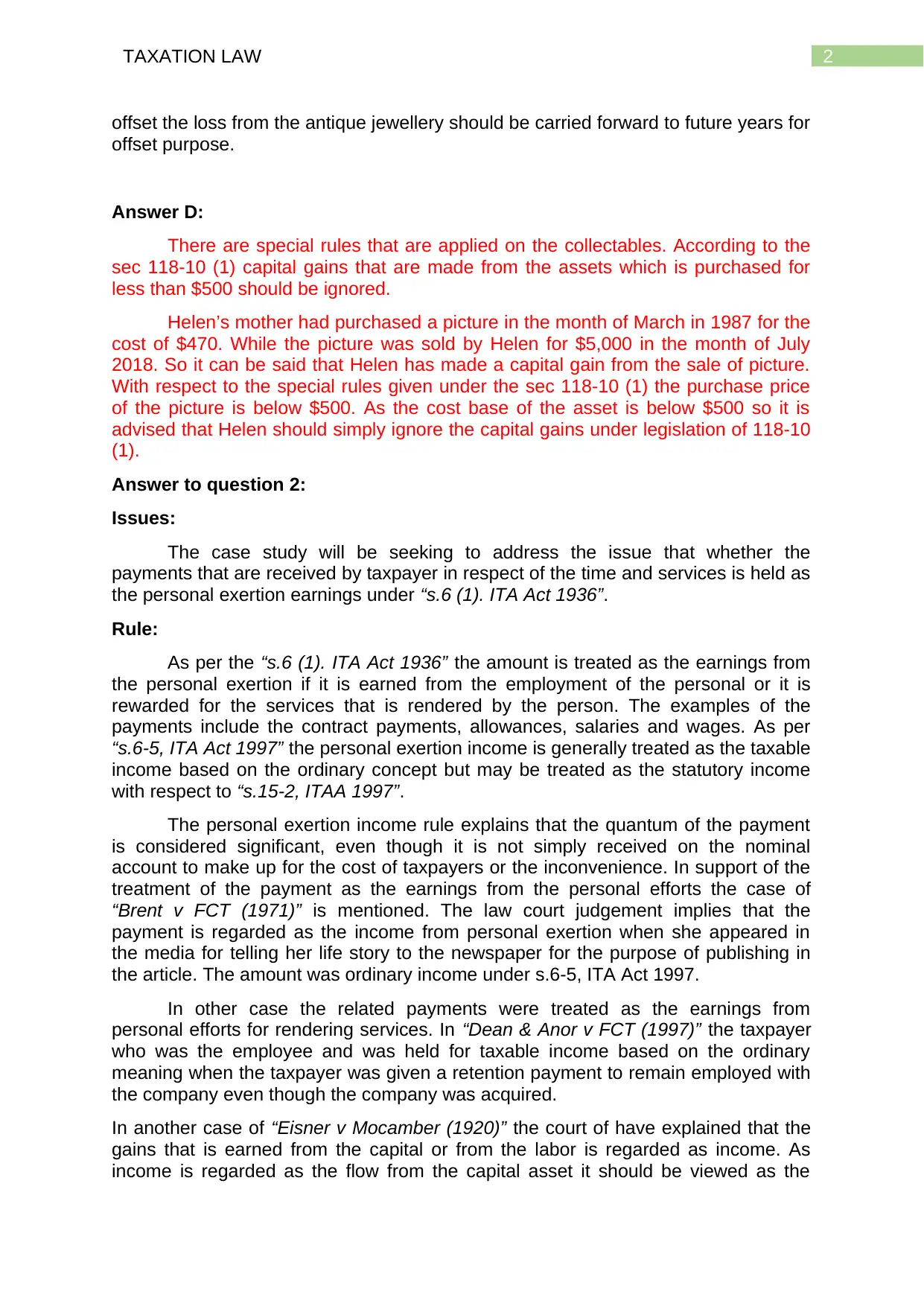
2TAXATION LAW
offset the loss from the antique jewellery should be carried forward to future years for
offset purpose.
Answer D:
There are special rules that are applied on the collectables. According to the
sec 118-10 (1) capital gains that are made from the assets which is purchased for
less than $500 should be ignored.
Helen’s mother had purchased a picture in the month of March in 1987 for the
cost of $470. While the picture was sold by Helen for $5,000 in the month of July
2018. So it can be said that Helen has made a capital gain from the sale of picture.
With respect to the special rules given under the sec 118-10 (1) the purchase price
of the picture is below $500. As the cost base of the asset is below $500 so it is
advised that Helen should simply ignore the capital gains under legislation of 118-10
(1).
Answer to question 2:
Issues:
The case study will be seeking to address the issue that whether the
payments that are received by taxpayer in respect of the time and services is held as
the personal exertion earnings under “s.6 (1). ITA Act 1936”.
Rule:
As per the “s.6 (1). ITA Act 1936” the amount is treated as the earnings from
the personal exertion if it is earned from the employment of the personal or it is
rewarded for the services that is rendered by the person. The examples of the
payments include the contract payments, allowances, salaries and wages. As per
“s.6-5, ITA Act 1997” the personal exertion income is generally treated as the taxable
income based on the ordinary concept but may be treated as the statutory income
with respect to “s.15-2, ITAA 1997”.
The personal exertion income rule explains that the quantum of the payment
is considered significant, even though it is not simply received on the nominal
account to make up for the cost of taxpayers or the inconvenience. In support of the
treatment of the payment as the earnings from the personal efforts the case of
“Brent v FCT (1971)” is mentioned. The law court judgement implies that the
payment is regarded as the income from personal exertion when she appeared in
the media for telling her life story to the newspaper for the purpose of publishing in
the article. The amount was ordinary income under s.6-5, ITA Act 1997.
In other case the related payments were treated as the earnings from
personal efforts for rendering services. In “Dean & Anor v FCT (1997)” the taxpayer
who was the employee and was held for taxable income based on the ordinary
meaning when the taxpayer was given a retention payment to remain employed with
the company even though the company was acquired.
In another case of “Eisner v Mocamber (1920)” the court of have explained that the
gains that is earned from the capital or from the labor is regarded as income. As
income is regarded as the flow from the capital asset it should be viewed as the
offset the loss from the antique jewellery should be carried forward to future years for
offset purpose.
Answer D:
There are special rules that are applied on the collectables. According to the
sec 118-10 (1) capital gains that are made from the assets which is purchased for
less than $500 should be ignored.
Helen’s mother had purchased a picture in the month of March in 1987 for the
cost of $470. While the picture was sold by Helen for $5,000 in the month of July
2018. So it can be said that Helen has made a capital gain from the sale of picture.
With respect to the special rules given under the sec 118-10 (1) the purchase price
of the picture is below $500. As the cost base of the asset is below $500 so it is
advised that Helen should simply ignore the capital gains under legislation of 118-10
(1).
Answer to question 2:
Issues:
The case study will be seeking to address the issue that whether the
payments that are received by taxpayer in respect of the time and services is held as
the personal exertion earnings under “s.6 (1). ITA Act 1936”.
Rule:
As per the “s.6 (1). ITA Act 1936” the amount is treated as the earnings from
the personal exertion if it is earned from the employment of the personal or it is
rewarded for the services that is rendered by the person. The examples of the
payments include the contract payments, allowances, salaries and wages. As per
“s.6-5, ITA Act 1997” the personal exertion income is generally treated as the taxable
income based on the ordinary concept but may be treated as the statutory income
with respect to “s.15-2, ITAA 1997”.
The personal exertion income rule explains that the quantum of the payment
is considered significant, even though it is not simply received on the nominal
account to make up for the cost of taxpayers or the inconvenience. In support of the
treatment of the payment as the earnings from the personal efforts the case of
“Brent v FCT (1971)” is mentioned. The law court judgement implies that the
payment is regarded as the income from personal exertion when she appeared in
the media for telling her life story to the newspaper for the purpose of publishing in
the article. The amount was ordinary income under s.6-5, ITA Act 1997.
In other case the related payments were treated as the earnings from
personal efforts for rendering services. In “Dean & Anor v FCT (1997)” the taxpayer
who was the employee and was held for taxable income based on the ordinary
meaning when the taxpayer was given a retention payment to remain employed with
the company even though the company was acquired.
In another case of “Eisner v Mocamber (1920)” the court of have explained that the
gains that is earned from the capital or from the labor is regarded as income. As
income is regarded as the flow from the capital asset it should be viewed as the
⊘ This is a preview!⊘
Do you want full access?
Subscribe today to unlock all pages.

Trusted by 1+ million students worldwide
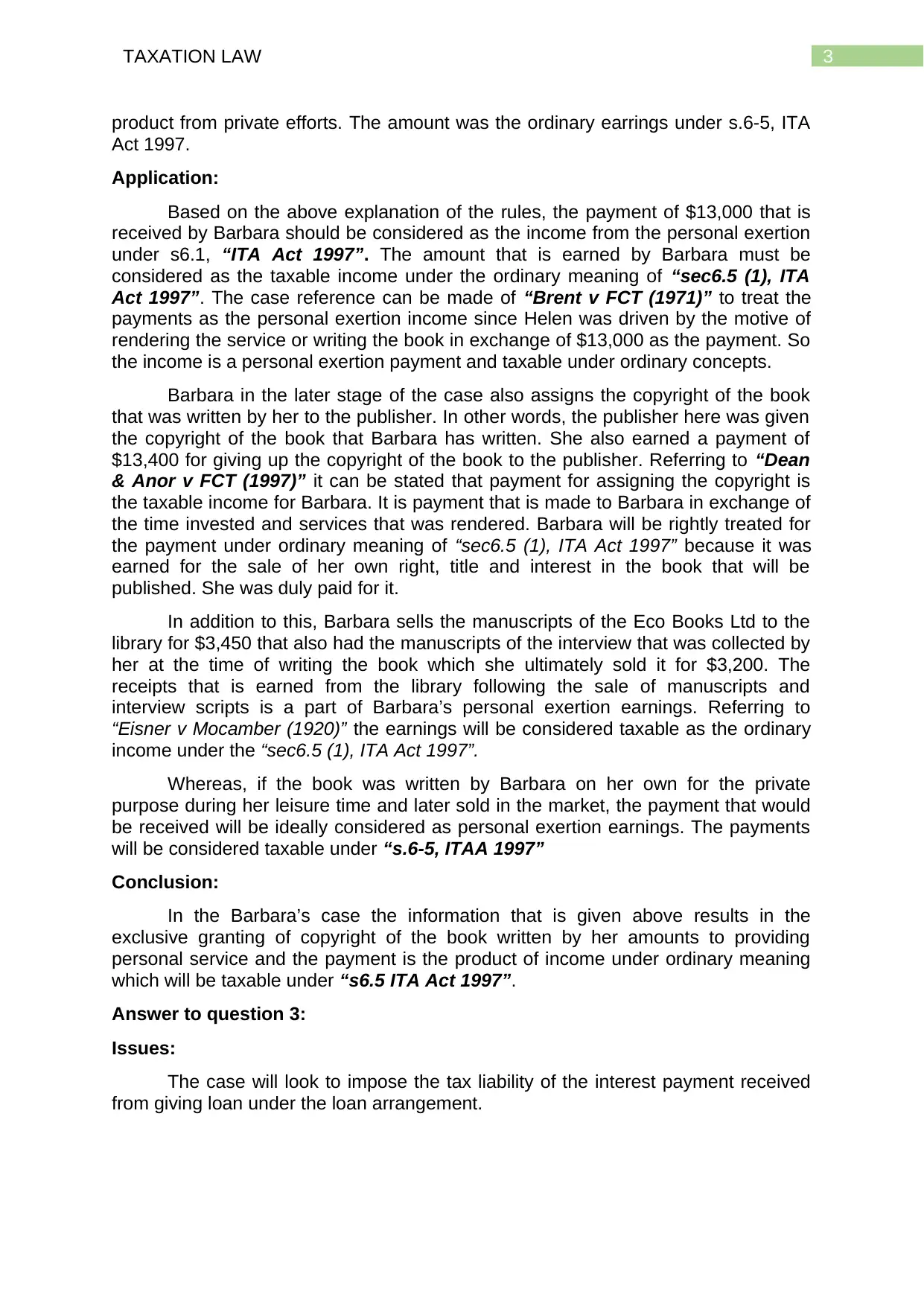
3TAXATION LAW
product from private efforts. The amount was the ordinary earrings under s.6-5, ITA
Act 1997.
Application:
Based on the above explanation of the rules, the payment of $13,000 that is
received by Barbara should be considered as the income from the personal exertion
under s6.1, “ITA Act 1997”. The amount that is earned by Barbara must be
considered as the taxable income under the ordinary meaning of “sec6.5 (1), ITA
Act 1997”. The case reference can be made of “Brent v FCT (1971)” to treat the
payments as the personal exertion income since Helen was driven by the motive of
rendering the service or writing the book in exchange of $13,000 as the payment. So
the income is a personal exertion payment and taxable under ordinary concepts.
Barbara in the later stage of the case also assigns the copyright of the book
that was written by her to the publisher. In other words, the publisher here was given
the copyright of the book that Barbara has written. She also earned a payment of
$13,400 for giving up the copyright of the book to the publisher. Referring to “Dean
& Anor v FCT (1997)” it can be stated that payment for assigning the copyright is
the taxable income for Barbara. It is payment that is made to Barbara in exchange of
the time invested and services that was rendered. Barbara will be rightly treated for
the payment under ordinary meaning of “sec6.5 (1), ITA Act 1997” because it was
earned for the sale of her own right, title and interest in the book that will be
published. She was duly paid for it.
In addition to this, Barbara sells the manuscripts of the Eco Books Ltd to the
library for $3,450 that also had the manuscripts of the interview that was collected by
her at the time of writing the book which she ultimately sold it for $3,200. The
receipts that is earned from the library following the sale of manuscripts and
interview scripts is a part of Barbara’s personal exertion earnings. Referring to
“Eisner v Mocamber (1920)” the earnings will be considered taxable as the ordinary
income under the “sec6.5 (1), ITA Act 1997”.
Whereas, if the book was written by Barbara on her own for the private
purpose during her leisure time and later sold in the market, the payment that would
be received will be ideally considered as personal exertion earnings. The payments
will be considered taxable under “s.6-5, ITAA 1997”
Conclusion:
In the Barbara’s case the information that is given above results in the
exclusive granting of copyright of the book written by her amounts to providing
personal service and the payment is the product of income under ordinary meaning
which will be taxable under “s6.5 ITA Act 1997”.
Answer to question 3:
Issues:
The case will look to impose the tax liability of the interest payment received
from giving loan under the loan arrangement.
product from private efforts. The amount was the ordinary earrings under s.6-5, ITA
Act 1997.
Application:
Based on the above explanation of the rules, the payment of $13,000 that is
received by Barbara should be considered as the income from the personal exertion
under s6.1, “ITA Act 1997”. The amount that is earned by Barbara must be
considered as the taxable income under the ordinary meaning of “sec6.5 (1), ITA
Act 1997”. The case reference can be made of “Brent v FCT (1971)” to treat the
payments as the personal exertion income since Helen was driven by the motive of
rendering the service or writing the book in exchange of $13,000 as the payment. So
the income is a personal exertion payment and taxable under ordinary concepts.
Barbara in the later stage of the case also assigns the copyright of the book
that was written by her to the publisher. In other words, the publisher here was given
the copyright of the book that Barbara has written. She also earned a payment of
$13,400 for giving up the copyright of the book to the publisher. Referring to “Dean
& Anor v FCT (1997)” it can be stated that payment for assigning the copyright is
the taxable income for Barbara. It is payment that is made to Barbara in exchange of
the time invested and services that was rendered. Barbara will be rightly treated for
the payment under ordinary meaning of “sec6.5 (1), ITA Act 1997” because it was
earned for the sale of her own right, title and interest in the book that will be
published. She was duly paid for it.
In addition to this, Barbara sells the manuscripts of the Eco Books Ltd to the
library for $3,450 that also had the manuscripts of the interview that was collected by
her at the time of writing the book which she ultimately sold it for $3,200. The
receipts that is earned from the library following the sale of manuscripts and
interview scripts is a part of Barbara’s personal exertion earnings. Referring to
“Eisner v Mocamber (1920)” the earnings will be considered taxable as the ordinary
income under the “sec6.5 (1), ITA Act 1997”.
Whereas, if the book was written by Barbara on her own for the private
purpose during her leisure time and later sold in the market, the payment that would
be received will be ideally considered as personal exertion earnings. The payments
will be considered taxable under “s.6-5, ITAA 1997”
Conclusion:
In the Barbara’s case the information that is given above results in the
exclusive granting of copyright of the book written by her amounts to providing
personal service and the payment is the product of income under ordinary meaning
which will be taxable under “s6.5 ITA Act 1997”.
Answer to question 3:
Issues:
The case will look to impose the tax liability of the interest payment received
from giving loan under the loan arrangement.
Paraphrase This Document
Need a fresh take? Get an instant paraphrase of this document with our AI Paraphraser
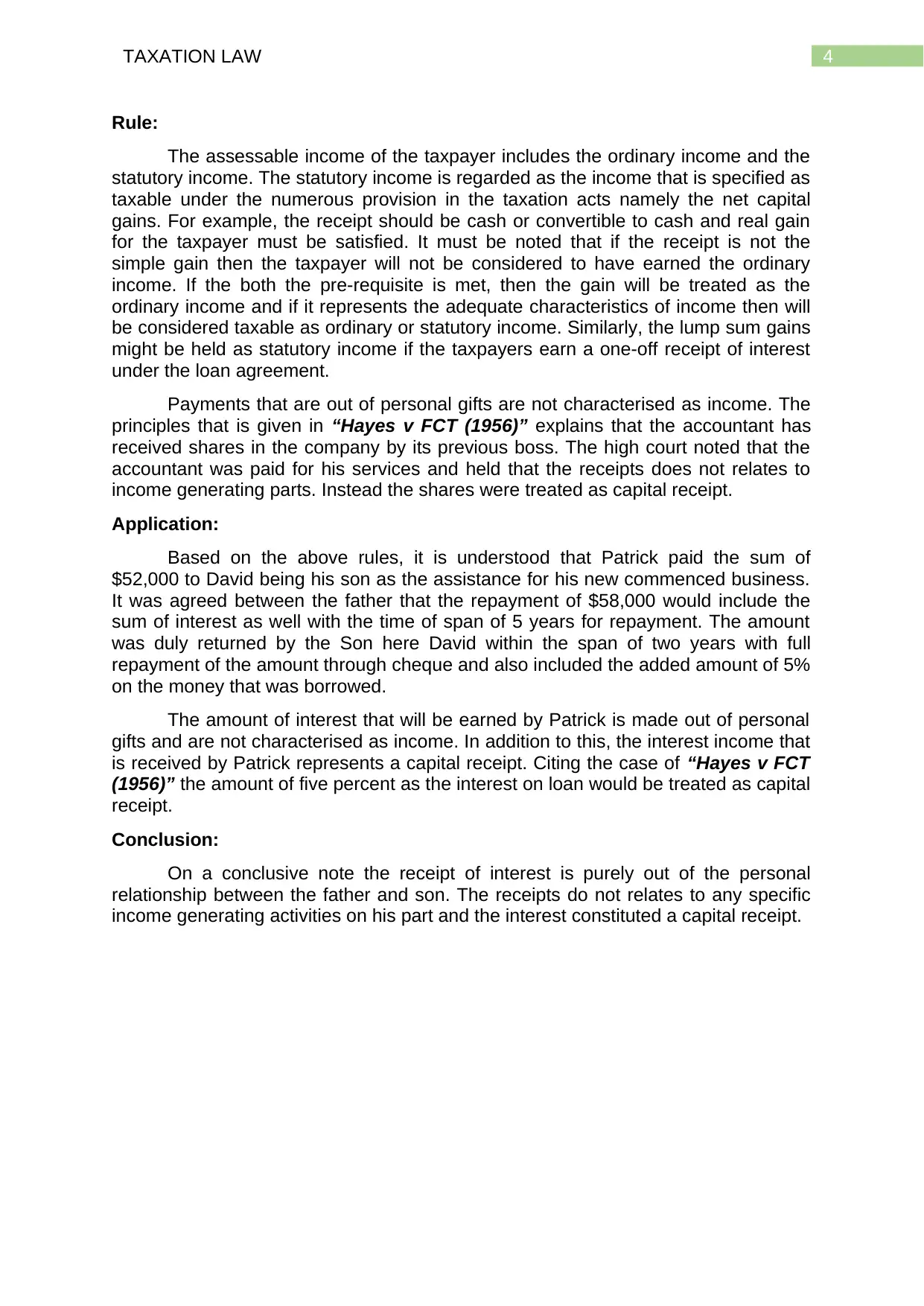
4TAXATION LAW
Rule:
The assessable income of the taxpayer includes the ordinary income and the
statutory income. The statutory income is regarded as the income that is specified as
taxable under the numerous provision in the taxation acts namely the net capital
gains. For example, the receipt should be cash or convertible to cash and real gain
for the taxpayer must be satisfied. It must be noted that if the receipt is not the
simple gain then the taxpayer will not be considered to have earned the ordinary
income. If the both the pre-requisite is met, then the gain will be treated as the
ordinary income and if it represents the adequate characteristics of income then will
be considered taxable as ordinary or statutory income. Similarly, the lump sum gains
might be held as statutory income if the taxpayers earn a one-off receipt of interest
under the loan agreement.
Payments that are out of personal gifts are not characterised as income. The
principles that is given in “Hayes v FCT (1956)” explains that the accountant has
received shares in the company by its previous boss. The high court noted that the
accountant was paid for his services and held that the receipts does not relates to
income generating parts. Instead the shares were treated as capital receipt.
Application:
Based on the above rules, it is understood that Patrick paid the sum of
$52,000 to David being his son as the assistance for his new commenced business.
It was agreed between the father that the repayment of $58,000 would include the
sum of interest as well with the time of span of 5 years for repayment. The amount
was duly returned by the Son here David within the span of two years with full
repayment of the amount through cheque and also included the added amount of 5%
on the money that was borrowed.
The amount of interest that will be earned by Patrick is made out of personal
gifts and are not characterised as income. In addition to this, the interest income that
is received by Patrick represents a capital receipt. Citing the case of “Hayes v FCT
(1956)” the amount of five percent as the interest on loan would be treated as capital
receipt.
Conclusion:
On a conclusive note the receipt of interest is purely out of the personal
relationship between the father and son. The receipts do not relates to any specific
income generating activities on his part and the interest constituted a capital receipt.
Rule:
The assessable income of the taxpayer includes the ordinary income and the
statutory income. The statutory income is regarded as the income that is specified as
taxable under the numerous provision in the taxation acts namely the net capital
gains. For example, the receipt should be cash or convertible to cash and real gain
for the taxpayer must be satisfied. It must be noted that if the receipt is not the
simple gain then the taxpayer will not be considered to have earned the ordinary
income. If the both the pre-requisite is met, then the gain will be treated as the
ordinary income and if it represents the adequate characteristics of income then will
be considered taxable as ordinary or statutory income. Similarly, the lump sum gains
might be held as statutory income if the taxpayers earn a one-off receipt of interest
under the loan agreement.
Payments that are out of personal gifts are not characterised as income. The
principles that is given in “Hayes v FCT (1956)” explains that the accountant has
received shares in the company by its previous boss. The high court noted that the
accountant was paid for his services and held that the receipts does not relates to
income generating parts. Instead the shares were treated as capital receipt.
Application:
Based on the above rules, it is understood that Patrick paid the sum of
$52,000 to David being his son as the assistance for his new commenced business.
It was agreed between the father that the repayment of $58,000 would include the
sum of interest as well with the time of span of 5 years for repayment. The amount
was duly returned by the Son here David within the span of two years with full
repayment of the amount through cheque and also included the added amount of 5%
on the money that was borrowed.
The amount of interest that will be earned by Patrick is made out of personal
gifts and are not characterised as income. In addition to this, the interest income that
is received by Patrick represents a capital receipt. Citing the case of “Hayes v FCT
(1956)” the amount of five percent as the interest on loan would be treated as capital
receipt.
Conclusion:
On a conclusive note the receipt of interest is purely out of the personal
relationship between the father and son. The receipts do not relates to any specific
income generating activities on his part and the interest constituted a capital receipt.
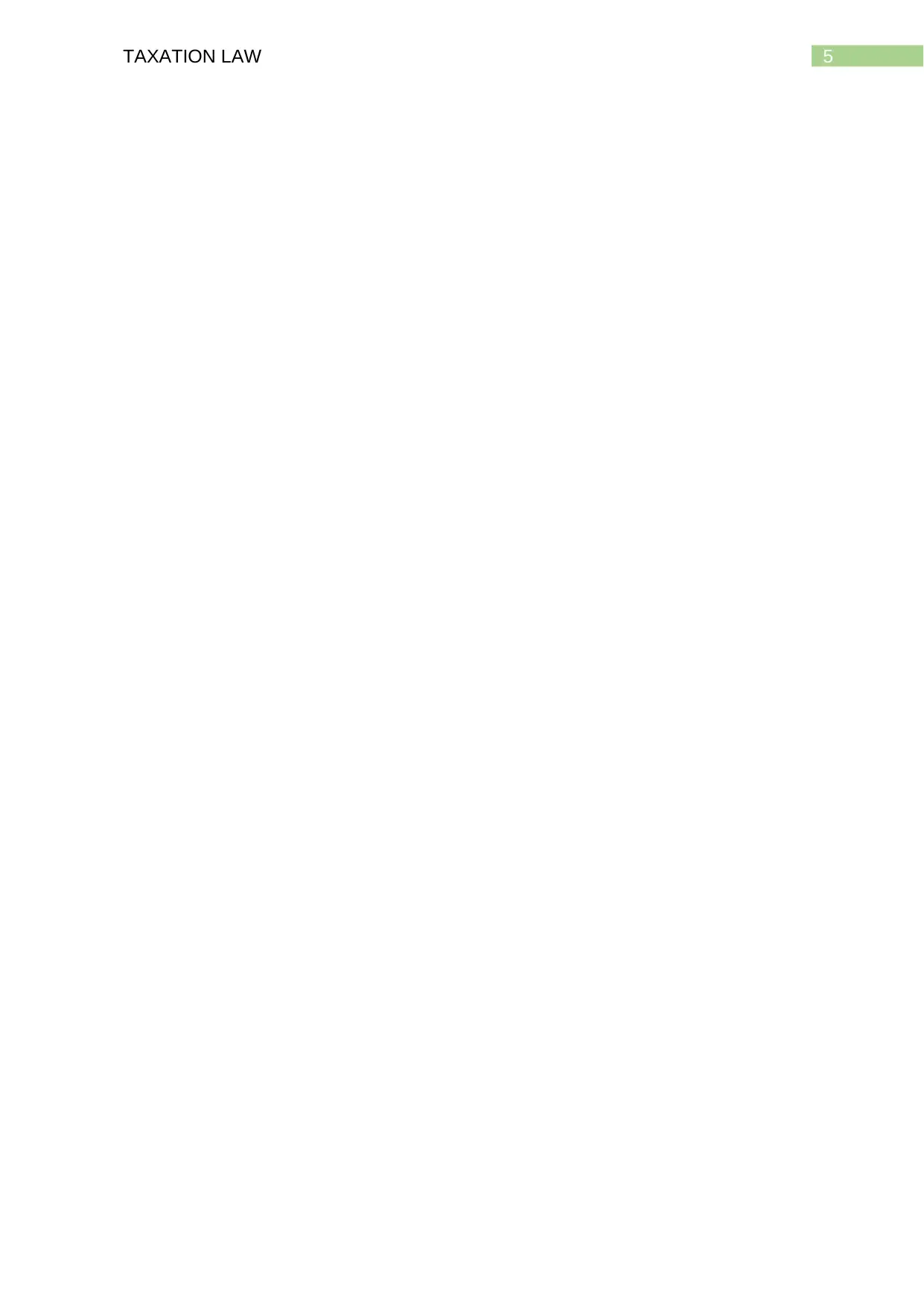
5TAXATION LAW
⊘ This is a preview!⊘
Do you want full access?
Subscribe today to unlock all pages.

Trusted by 1+ million students worldwide
1 out of 6
Related Documents
Your All-in-One AI-Powered Toolkit for Academic Success.
+13062052269
info@desklib.com
Available 24*7 on WhatsApp / Email
![[object Object]](/_next/static/media/star-bottom.7253800d.svg)
Unlock your academic potential
Copyright © 2020–2025 A2Z Services. All Rights Reserved. Developed and managed by ZUCOL.





